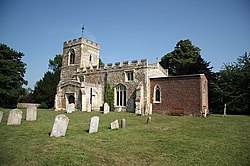Hinxworth
| Hinxworth | |
| Hertfordshire | |
|---|---|
 St Nicholas, Hinxworth | |
| Location | |
| Grid reference: | TL236405 |
| Location: | 52°2’56"N, 0°11’56"W |
| Data | |
| Post town: | Baldock |
| Postcode: | SG7 |
| Local Government | |
| Council: | North Hertfordshire |
| Parliamentary constituency: |
North East Hertfordshire |
Hinxworth is a village in northern Hertfordshire. It sits just off the Great North Road between Baldock and Biggleswade, with just over 100 inhabitants, a village hall, a park, a pub, a small church.
The name of the village has variously been recorded as Haingesteworde, Hainsteworde, Hamsteworde (in the 11th century); Hingslewurd (12th century); Hengsteworth, Hyngstrigge, Heynceworth (13th century); Hangteworth, Hynxworth (14th century); Hyggextworth, Hyngxtworth (15th century); and Henxworth (16th century).
The parish of Hinxworth is in the extreme north of the county on the borders of Cambridgeshire and Bedfordshire. It lies low, the ground nowhere rising more than 172 feet above mean sea level. The ancient track called the Ridgeway crosses the low land to the east of the parish, running parallel with the River Rhee, which forms the north-east boundary. The area of the parish is 1,463 acres, most of them arable land, the remainder woodland and pasture. The soil is loam and blue clay, the subsoil varies. The chief crops are wheat, barley, field beans and oilseed rape. Coprolites have been dug in the parish and are still to be found. An Act authorizing enclosure of the common fields was passed in 1802 and the award was made in 1806.
The A1 Great North Road skirts the parish on the west and forms its south-west boundary. Not far from this road, on the borders of Hinxworth and Caldecote, Roman remains were discovered in about 1720 by workmen who were digging there for gravel with which to repair the road. These included several human bodies, urns, paterae and other objects, with a Danish or Dutch coin. In 1810 a further find of great interest was made in the parish of two rare Greek coins or medals, one of Mithridates King of Pontus, and the other of Perseus King of Macedonia, both very well preserved. Near the River Rhee in the north of the parish and not far from the camp at Arbury Banks or Harboro, and near the Ridgeway, a hoard of more than 500 Roman coins was discovered. Near them were found other Roman remains.
The village of Hinxworth lies a mile and a half to the east of the Roman road, with which it is connected by roads leading northwest and southwest, the former continuing to Ashwell. The church and former rectory stand on the southeast of the angle formed by the road to Ashwell and that leading southwest to the Roman road, and the village lies a little to the northwest of the church.
At the beginning of the 18th century it had only thirty-five houses, of which three were almshouses.[1]
The mediæval manor house Hinxworth Place is about half a mile southwest of the village.
Monica Dickens
The author Monica Dickens lived in a cottage in the village for four years from 1947 to 1951. Here she wrote her novels Flowers on the Grass (1949) and My Turn to Make the Tea (1951), the latter based on her experiences as a reporter working on the Herts Express in Hitchin.[2]
While there she lived here she was the Treasurer of the annual Ashwell Horse Show and President of the Hinxworth Cricket Club, having bought maroon blazers for all the team, the umpire and the Club Secretary.
Outside links
| ("Wikimedia Commons" has material about Hinxworth) |
References
- ↑ Victoria County History, Hertfordshire
- ↑ Dickens, Monica An Open Book, Mayflower Books/Heinemann (1978) pgs 111-122